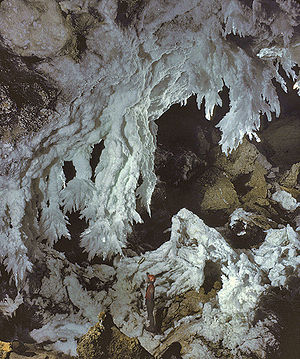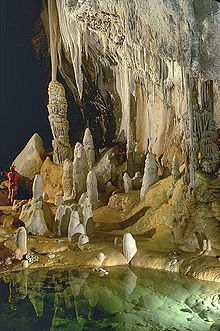- Lechuguilla Cave
-
Lechuguilla Cave is, as of June 2011, the sixth longest cave (130.24 miles (210 km)) known to exist in the world, and the deepest in the continental United States (1,604 feet (489 m)), but it is most famous for its unusual geology, rare formations, and pristine condition.
The cave is named for Agave lechuguilla, a plant found near its entrance. It is located in Carlsbad Caverns National Park, New Mexico. Access to the cave is limited to approved scientific researchers, survey and exploration teams, and National Park Service management-related trips.
Contents
Exploration history
Lechuguilla Cave was known until 1986 as a small, fairly insignificant historic site in the park's backcountry. Small amounts of bat guano were mined from the entrance passages for a year under a mining claim filed in 1914. The historic cave contained a 90-foot (27 m) entrance pit known as Misery Hole, which led to 400 feet (122 m) of dry dead-end passages.[1]
The cave was visited infrequently after mining activities ceased. However, in the 1950s cavers heard wind roaring up from the rubble-choked floor of the cave. Although there was no obvious route, different people concluded that cave passages lay below the rubble. A group of Colorado cavers gained permission from the National Park Service and began digging in 1984. The breakthrough, into large walking passages, occurred on May 26, 1986.[1]
Since 1986, explorers have mapped over 130 miles (209 km) of passages[2] and have pushed the depth of the cave to 1,604 feet (489 m),[2] ranking Lechuguilla as the 6th longest cave in the world (4th longest in the United States)[2] and the deepest limestone cave in the country. Cavers, drawn by the caves' pristine condition and rare beauty, come from around the world to explore and map its passages and geology.[1]
Geology
Lechuguilla Cave offered even more than just its extreme size. Cavers were greeted by large amounts of gypsum and lemon-yellow sulfur deposits. A large variety of rare speleothems, some of which had never been seen anywhere in the world, included 20 feet (6.1 m) gypsum chandeliers, 20 feet (6.1 m) gypsum hairs and beards, 15 feet (4.6 m) soda straws, hydromagnesite balloons, cave pearls, subaqueous helictites, rusticles, U-loops and J-loops. Lechuguilla Cave surpassed its nearby sister, Carlsbad Caverns, in size, depth, and variety of speleothems, though no room has been discovered yet in Lechuguilla Cave which is larger than Carlsbad's Big Room.[1]
Scientific exploration has been conducted as well. For the first time a Guadalupe Mountains cave extends deep enough that scientists may study five separate geologic formations from the inside. The profusion of gypsum and sulfur lends support to speleogenesis by sulfuric acid dissolution. The sulfuric acid is believed to be derived from hydrogen sulfide which migrated from nearby oil deposits. Thus, this cavern (as well as Carlsbad Caverns) apparently formed from the bottom up, in contrast to the normal top-down carbonic acid dissolution mechanism of cave formation.[1]
Rare, chemolithoautotrophic bacteria are believed to occur in the cave. These bacteria feed on the sulfur, iron, and manganese minerals and may assist in enlarging the cave and determining the shapes of some unusual speleothems. Other studies indicate that some microbes may have medicinal qualities that are beneficial to humans.[1]
Lechuguilla Cave lies beneath a park wilderness area. However, it appears that the cave's passages may extend out of the park into adjacent Bureau of Land Management (BLM) land. A major threat to the cave is proposed gas and oil drilling on BLM land. Any leakage of gas or fluids into the cave's passages could kill cave life or cause explosions.[1]
Filming
Lechuguilla Cave was shown in the BBC documentary series Planet Earth. The fourth episode, titled "Caves", aired on April 22, 2007 and documented a team of scientists and filmmakers exploring Lechuguilla cave including the Chandelier Ballroom where high quality crystals are found. It took the team two years to get permission to film the cave and local authorities are unlikely to allow another film crew to enter in the foreseeable future.[3]
The Denver Museum of Natural History (now known as the Denver Museum of Nature and Science) filmed one of the first documentaries in the cave titled "Lechuguilla Cave: The Hidden Giant" in 1987 featuring many of the cavers responsible for the breakthrough and initial survey work. The video was broadcast on the Denver PBS station KRMA in 1989 and was available for purchase at the Denver Museum until the early 1990s.
The National Geographic Society program titled Mysteries Underground was also filmed extensively in Lechuguilla Cave.[citation needed]
Fiction
Lechuguilla is the location of the Nevada Barr mystery starring Anna Pigeon, Blind Descent.
References
- ^ a b c d e f g "Carlsbad Caverns National Park: Lechuguilla Cave". NPS. http://www.nps.gov/cave/naturescience/lechuguilla_cave.htm. Retrieved 2009-01-22.
- ^ a b c Bob Gulden. "USA Longest Caves". http://www.caverbob.com/usalong.htm. Retrieved September 2, 2009.
- ^ "Caves". Planet Earth. 2007-04-22. No. 4, season 1.
External links
Categories:- Caves of New Mexico
- Limestone caves
- Wild caves
- Landforms of Eddy County, New Mexico
- Carlsbad Caverns National Park
Wikimedia Foundation. 2010.


